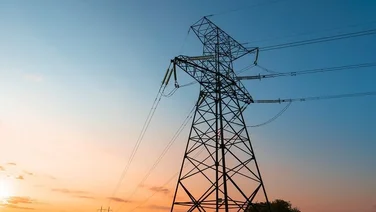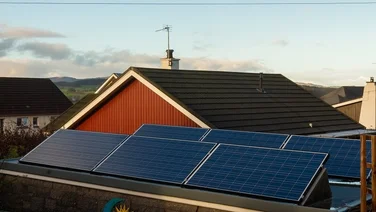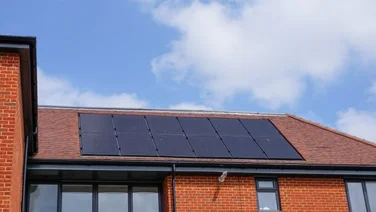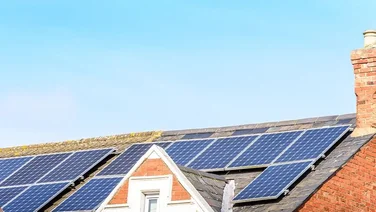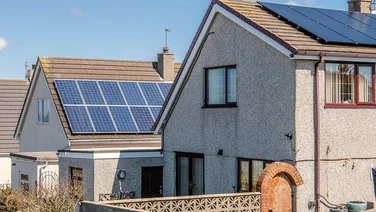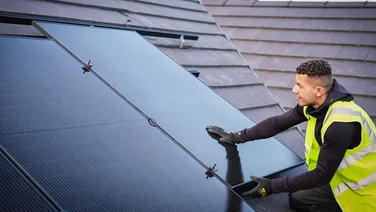- Depending on your solar array, you may be able to retrofit a solar battery
- There are four types of solar battery, so choose wisely
- Installation is fairly straightforward with minimal disruption

Whether you’re looking to store excess energy generated by your solar panels or have a backup power source during blackouts, installing a solar battery can be a smart investment.
In this article, we’ll guide you through the ins and outs of solar battery installation – from choosing the best solar batteries to understanding the installation process, we’ve got you covered.
If you’re already eager to explore how solar panels and batteries can transform your home, we can help. Share your details in our quick web form and we’ll send you some free quotes to kick-start your sustainable energy journey.
Where do you want to install solar panels?
Get startedHow is a solar battery installed?
Installing a solar battery is a great way to maximise the benefits of your solar panels, as it stores the excess energy generated. Think of it as having a power bank for your home.
Just like the palm-sized versions you throw into your bag, a solar battery will allow you to use this stored energy when you’ve run out of juice – i.e., when the sun isn’t shining, like during the night or on very cloudy days.
Here are the steps involved in fitting your very own house-sized power bank:
1. Assessment and planning
Before you start your solar battery installation, make sure you know how much backup energy you’ll need. This means getting a clear understanding of your household electricity consumption habits from recent meter readings and appliance power ratings.
Once you have this information, you can make informed decisions about the best set-up and solar battery size for you. After all, there’s no point in investing in a system that can’t meet your energy needs.
2. Battery selection
The next major decision is choosing your solar battery type. The four primary types are lithium-ion, lead-acid, nickel cadmium, and flow batteries, each with their specific advantages and considerations.
To make sure you make the right choice for your setup, you’ll need to consider aspects like capacity, lifespan, efficiency, and warranties. Unsure where to start? Ask an expert to help you pick the perfect solar battery.
If you’d like to know that latest solar battery price, have a look at our dedicated page.
3. Setting up the solar panel system
The great thing about solar batteries is that you have the option to either install them at the same time as getting a new solar panel system in place, or you can choose a system that will allow you to retrofit them later.
Either way, this step involves making sure your solar photovoltaic (PV) panels and inverter are ready to complete the initial conversion of sunlight into usable electricity.
This is the point where your installer will make sure you can get the most out of your energy production by locking in the proper placement and connection.
One of the most common questions we get asked is: what are the best solar panels? The answer will depend on your budget, your energy output and your home, among other things. To find the best solar panel for you, visit our dedicated page.
4. Battery installation and configuration
Now, it’s time to install the solar battery. This involves making sure your battery is securely placed and correctly wired to the inverter and solar system.
Making sure the battery system is configured properly is key to getting the most out of it. Professional installers will thoroughly test the system to ensure it integrates seamlessly with your solar panels.
5. Monitoring and maintenance
After installation, you need to monitor your solar battery’s performance to make sure it’s working properly. Many solar systems come with monitoring apps or software to help you track energy production, consumption, and battery status.
Doing some basic routine maintenance, like checking for loose connections and cleaning battery terminals, will keep your system going strong for a long time. Regular check-ins can help you save money and energy in the long run.
Where’s the best place to install a solar battery?
The ideal location for installing a solar battery depends on various factors, including your available space, local climate, and personal preferences. Ideally, you’ll be able to keep the battery close enough to your panels and at an ambient temperature so it can work efficiently.
Typically, a garage or utility room is a popular choice for indoor installations, providing easy access for maintenance and protection from extreme temperatures. You could also put it in your loft, but it might be a pain to get to for maintenance.
If there’s not enough room indoors, you can go with an outdoor enclosure that can handle the weather. But you might need to take some extra steps to stop it from getting too hot or cold.
Ultimately, it’s a good idea to speak with a professional installer to find the best location for your solar battery system. This will keep it performing well in the long run.
Where do you want to install solar panels?
Get started
How long does a solar battery installation take?
There’s no one answer for how long it takes to install a solar battery, as it depends on factors like how complex the setup is, how big the battery is, and the site conditions. As you can imagine, more elaborate installations will take longer.
If you’re having panels installed as well, it could take anywhere from a few hours to a few days. This covers everything from checking what you need, setting up the system, and doing extensive tests.
Can you use electricity at home during the installation?
You can typically continue using electricity at home during a solar battery installation. The process primarily involves connecting and configuring the solar battery system via your solar inverter, which rarely requires disconnecting your existing power source.
Your installer will ensure that the transition is seamless, allowing you to enjoy uninterrupted electricity while your solar battery system is being set up.
Can you do a solar battery installation yourself?
While some individuals with advanced DIY skills might be tempted to attempt a solar battery installation themselves, we’d strongly recommend seeking professional help from an accredited solar installer.
If you’re unsure how to choose a solar panel company, read our handy guide for the things you should be looking out for.
Solar battery systems involve complex electrical work, safety considerations, and regulatory compliance with local regulations. A professional can put your mind at ease by installing your solar battery system correctly and making sure it runs smoothly, which is important for both your investment and safety.
Summary
By adding a solar battery to your energy plan, you’re taking a step toward energy independence from the grid and reducing your carbon footprint.
Now that you have a better grasp of the installation process, it’s time to take action. Let our experts match you with free quotes for solar panels and solar battery solutions and unlock a brighter, greener future for your home – just pop your details in here to get started.

